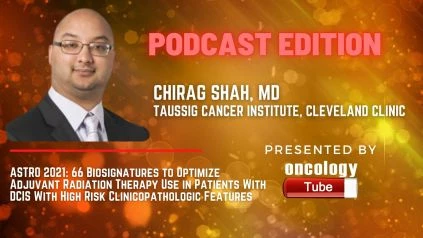Chirag Shah, MD, Department of Radiation Oncology, Taussig Cancer Institute, Cleveland Clinic speaks about the ASTRO 2021 Abstract – 66 Biosignatures to Optimize Adjuvant Radiation Therapy Use in Patients With DCIS With High Risk Clinicopathologic Features.
Link to Abstract:
https://plan.core-apps.com/myastroapp2021/abstract/b6437add-873a-4710-b4bd-0153a3d5cb8b
Intention:
There is an unmet need to identify women with DCIS who have a low recurrence risk and could avoid radiotherapy (RT) after breast-conserving surgery (BCS), as well as those who have a high recurrence risk after BCS plus RT.
Components:
At sites in Sweden, the United States, and Australia, pathology, clinical data, and FFPE tissue samples were evaluated for 485 women treated for DCIS with BCS with negative margins, with or without whole breast RT. A subset (n=250) of patients with big tumors (>2.5 cm) and/or nuclear grade III DCIS was evaluated. Protein biomarkers (p16/INK4A, Ki-67, COX-2, PgR, HER2, FOXA1, SIAH2) measured on FFPE tissue were used to determine a validated biosignature (Prelude, Laguna Hills CA) and a unique response subtype biosignature to RT following BCS. Low risk, the elevated risk with a good response subtype (Rst), and elevated risk with a poor Rst to RT following BCS were the three risk groups identified by the two biosignatures. DCIS or Invasive Breast Cancer (IBC) that was local, regional, or metastatic was classified as ipsilateral breast tumor recurrence (IBTR). Cox proportional hazards and Kaplan-Meier analyses were used to calculate hazard ratios and 10-year risks.
Outcomes:
Biosignatures classified 72 percent (n=179) of 250 women with nuclear grade III DCIS and/or a size >2.5 cm into an Elevated risk group, which included those who had a good (n=122) or poor (n=57) response subtype (Rst) to RT following BCS. The remaining 28% of women (n=71) were assigned to the Low-Risk category. Women treated without RT in the Low-Risk group (n=71) had satisfactory 10-year outcomes, with no 10-year IBC events (0%) and no significant RT advantage (1%) in 10-year IBTR rates (IBTR p=0.81). The Elevated risk group (good and poor Rst combined, n=61) had significantly worse 10-year IBTR/IBC rates (31 percent /17 percent) than the Low-risk group (IBTR HR=12, p=0.01) of all women treated without RT (n=102). The 10-year IBTR/IBC rates of women treated with RT in the Elevated risk group with a good Rst (n=77) were considerably reduced by 5% /3 percent. However, for women in the Elevated risk group with a poor Rst (n=41) who had 10-year IBTR/IBC rates of 25% /20%, there was no substantial benefit to RT. In the Elevated risk group (n=118) of all women treated with RT, those with a bad Rst had significantly worse outcomes than those with a good Rst (IBTR HR=4.1, p=0.035, IBC HR=8, p=0.053).
Summary:
DCISionRT paired with a unique response subtype biosignature (Rst) indicated an Elevated risk group with two distinct subtypes of women: (1) a bad Rst with high IBTR/IBC rates with or without RT, and (2) a good Rst with considerable benefit after adjuvant RT. The women in the Low-Risk group had low 10-year IBTR/IBC rates and did not benefit significantly from adjuvant RT.

